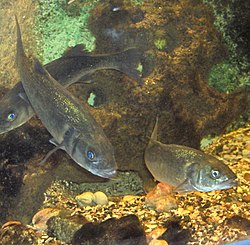Pair trawling
As the mouth of the net is kept open by the lateral pull of the individual vessels, otter boards are not required.
[1] As doors are not necessary, the gear arrangements are simplified, with the warps attaching directly to the wings of the net.
Setting and hauling of the nets are carried out by one boat, while the other is only used for towing; usually each will take turns at these operations.
Pair trawlers targeting cod off the coast of New England have reported average per vessel catches of three to six times that from single trawls.
This has caused some controversy, due to the high level of marine mammal bycatch associated, leading to the British government introducing a ban on pair trawling for bass in UK territorial waters.
